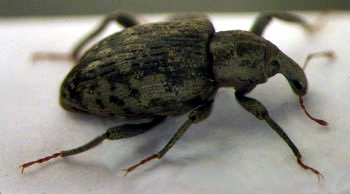Pests
Hydronomus sinuaticollis Faust. - Rice Water Weevil
Systematic position.
Class Insecta, order Coleoptera, family Curculionidae, genus Hydronomus Schoenherr.Biological group.
Pest of rice.Morphology and biology.
Body length is 4.5-7 mm; black in color, covered with continuous tiled vestiture, which consists of rounded, gray-brownish scales. Antennae and tarsus are reddish. Pronotum occasionally with light line medially and 2 light lateral limbations. Elytra concolorous or spotted, occasionally with 2 whitish spots in the midlength at both sides of suture. Rostrum slightly dilated toward apex, somewhat shorter than pronotum, with subapical antennal insertion. Eyes transverse, not protruding beyond the head contour. Pronotum as long as wide, widest distad of the midlength, with distinct postocular lobes. Anterior margin of prosternum without emargination. Elytra parallel-sided with distinct striae and humeral prominences. Scutellum easily visible. Tibia distinctly incurved; its inner margin indented with a row of long hairs. Tarsus narrow, 1st-3rd segments elongated, as wide as claw-segment, which is somewhat longer than 2nd and 3rd segments combined, claws are long and free. Larva is legless, last instar is whitish with reddish head. Body length 7-8 mm, dorsal side of the 3rd-5th abdominal segments with triangular denticles on each side.Distribution.
The species is widely distributed in the South of the European part of Russia, in the Caucasus, Middle Asia and Southern Kazakhstan.Ecology.
Monovoltine. Oligophage. Pupation is protracted from the beginning of April to June. The first adults appear and mate after rains from mid-May, occurring on self-sown rice. Adults migrate by flight and with water in irrigation canals. Mass flight occurs in evening after air temperature of 28-30°. Adults spend much of their time under water (10-12 hours). They feed under water by parenchyma on the stem and root. Oviposition begins before July; females lay eggs at the base of stem. Fertility is about 5-15 eggs. On the rice field under water, larvae live inside the root and take air from aeriferous plant structures. Larvae leave plants and devour roots from outside after water drain. Later they form soil cradle for diapause around the roots. Larva has 4 instars. Larvae density sometimes reaches 10-40 specimens per 1 host plant. Larvae in last instar hibernate mainly, and adults with immature larvae hibernate to a lesser degree.Economic significance.
Both adults and larvae cause damage. Adults injure late sowing rice seedlings. Light trap is used for the monitoring of adults. Control measures include autumn plowing when most larvae concentrate in the surface layer of the soil, and sowing rice at the earliest time. Pesticide treatment is necessary in spring after mass emergence of beetles.Reference citations:
Baitenov, M.S. 1974. The weevils (Coleoptera: Attelabidae, Curculionidae) of the Middle Asia and Kazakhstan. Alma-Ata: Nauka, 286 p. (in Russian).Chiong Tkhan, Zh. 1958. Turkestanish rice weevil. In: Avtonomov, A.I. & Balashov, N.N., eds. Collection of student papers (10). Tashkent: AN Uzbek.SSR: 85-100 (in Russian).
Chiong Tkhan, Zh. 1971. Rice water weevil Hydronomus sinuaticollis Fst., significance of the environmental conditions (temperature, humidity, land treatment) and pesticides. PhD Thesis. Tashkent: Tashkentskii SKhI, 19 p. (in Russian).
Korotyaev, A.B. 1980. Family Curculionidae. In : Kopaneva, L.M., ed. Key to harmful and useful insects and mites on grain plants in the USSR. Leningrad: Kolos, 335 p. (in Russian).
Sborshchikova, M.P. 1961. Preliminary data about Hydronomus sinuaticollis Fst. in Uzbekistan. In: Semenov, A.E. 1947. New pest of the rice in USSR . Hydronomus sinuaticollis Fst. Proceedings of VASKHNIL, (4). Moscow: USSR Ministry of Agriculture, 32-36 (in Russian).
Shchupakovskyi, V.P., ed. Proceedings of the Department of rice and other irrigated grain plants, (1). Tashkent: NII Khlopkovodstva, 70-74 (in Russian).
© David'yan G.E. (text & picture)


